

The Mac Studio is efficient, but slower than a PC
Apple’s fastest M2 Ultra chip that’s built into the new Mac Studio can power through almost anything – all while staying cool. But it’s a luxury product that’s outperformed in many areas by a Windows computer that costs half as much.
I’m looking at the Mac Studio with M2 Ultra, the fastest chip by Apple. The test device features a 24-core GPU, a 76-core GPU and 128 GB of RAM. It costs 6,619 francs or 7,329 euros if you buy it from Apple. This exact configuration is currently not available on our shop. We do, however, have one with even more working memory:

This silver cube presents me with a problem: how am I to judge whether it’s any good? Sure, I could compare it to other Macs, but that’s a bit pointless. Of course, the M2 Ultra is faster than the smaller chips of the same generation. For laptops, such a comparison is good enough, as Apple has left its Windows rival so far behind when it comes to build quality, display, speakers and battery life that the question is either which MacBook model you’re getting – or whether you’re going for Apple’s operating system at all.
It’s a different story with a high-end stationary computer, as these factors are less important or not relevant at all. What matters first and foremost is performance. That’s why the Mac Studio needs to be compared to a PC. By the way, I’m using «PC» as a synonym for Windows desktop computer – a historical inaccuracy.
Design and connections: small but nice
The new Mac Studio looks very similar to the first one. It’s a plain aluminium cube that’s about three times as tall as a Mac Mini. A cylindrical fan on the inside cools the system-on-a-chip (SoC) by drawing in air from below and releasing it through a perforated grille on the back. The design is simple and functional. I’m especially impressed with one small detail: the three-pin power cable with textile coating is soft and doesn’t curl. I wish all cables were like this one.
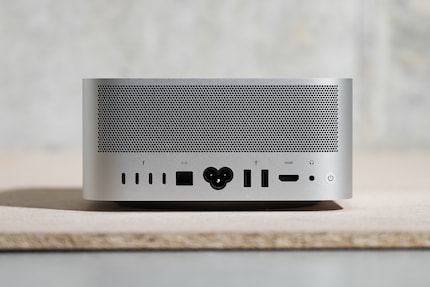
Source: Samuel Buchmann
It seems to me that in recent years, Apple’s been making an effort to provide good connectivity for professional products. The Mac Studio is no exception. In the version with M2 Ultra, it’s equipped with:
- 6 × USB-C (Thunderbolt 4)
- 2 × USB-A 3.0
- HDMI 2.1
- 10 Gigabit Ethernet
- WLAN 6E
- 3.5 mm jack plug
- SD card reader (UHS-II)
Up to eight 4K displays, six 6K displays or three 8K displays can be connected. If you have more than six monitors, you have to daisy chain at least two of them, i.e. to another monitor or a docking station.
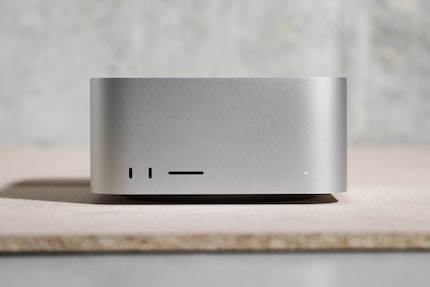
Source: Samuel Buchmann
Mac Studio vs. Mac: faster
First off, I want to rank the performance of the M2 Ultra chip within the Mac universe. The SoC is essentially two fused M2 Max chips. In certain benchmarks such as Cinebench R23, this results in double the performance, while in others, the M2 Ultra’s advantage over smaller chips isn’t as great.
In productivity applications such as video editing and image processing, the M2 Ultra is also significantly faster than any other Apple chip. However, this only really becomes noticeable when exporting projects or working with demanding effects. Or if you’re cutting extremely compute-intensive source material – 8K RAW from a RED camera, for instance. Applications such as Blender or After Effects also run more smoothly and render faster.
I don’t test the speed of the SSD in detail. It’s over 7,000 megabytes per second, which is very good and comparable to the fastest PCIe 4.0 SSDs.
Mac Studio vs. PC: slower
So far, no surprises. But what if I compare the Mac Studio to a high-end PC? For some people, Windows isn’t an option. For others, it’s the only option. There are good reasons for both. And there’s a middle ground, too. If you’re comfortable with both systems and use programs such as Blender, DaVinci Resolve, or the Adobe Suite, you have free choice. A PC will cost you less, even one with top components. My test configuration costs about 3,400 francs if you assemble it yourself. That’s only half as much as the M2 Ultra Mac Studio.
Time to get testing. Synthetic benchmarks offer some clues, but they’re usually optimised for either Mac or Windows.
The varying degrees of optimisation are evident in the CPU benchmarks. In the multi-core test of Cinebench R23, the Intel i9-13900K outperforms the Apple chip by 42 per cent. In Geekbench 6, however, the M2 Ultra is five per cent faster. The GPU benchmarks are even more difficult to compare because Mac and Windows use different programming interfaces. Games such as Tomb Raider also have to be translated with Rosetta 2. Nevertheless, the bottom line is that the Nvidia RTX 4090 offers more power than Apple’s SoC.
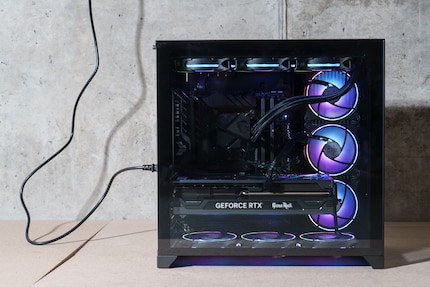
Source: Samuel Buchmann
Scenarios or benchmarks in real programs are more meaningful than synthetic benchmarks. Although they’re also not all ideally adapted to the individual systems, this reflects a daily work scenario.
This shows how important good coordination between hardware and software is. Although the PC packs both more CPU and GPU power, the Mac Studio comes close in many of my test scenarios.
In DaVinci Resolve Studio, the M2 Ultra exports my H.265 video eight per cent faster. With a mix of various formats and filters, on the other hand, the PC is 29 per cent faster. If you’re editing with Adobe applications, both systems are currently on par. The Mac has slight advantages in After Effects; the PC in Premiere Pro. When it comes to videos, Apple compensates a lot of raw processing power with its dedicated media engines. The M2 Ultra features four of these for encoding and two for decoding H.264 and H.265, plus another four for ProRes. Unlike the predecessor chip, two engines can be used simultaneously while exporting.
If you want to edit images, the tested systems are over the top – you don’t need such an expensive computer to use Lightroom and Photoshop. For the record, the PC is minimally slower in exporting 100 RAW images, but significantly faster with sophisticated filters such as AI-assisted noise reduction.
The Mac Studio has no chance when it comes to the 3D program Blender. It’s been supporting Apple’s Metal interface for GPU rendering for a few versions. But that doesn’t help, as the Nvidia RTX 4090 with OptiX engine completely outperforms Apple’s 76 GPU cores. It renders the test file in a quarter of the time. I don’t even bother comparing the gaming performance. After all, the vast majority of games are only available via inefficient detours on MacOS.
Efficiency: the true strength of the Mac Studio
The Mac Studio makes any powerful Windows device look like a bit of a fool when it comes to energy efficiency. With minimal loads such as playing YouTube, the silver cube uses just 12 watts, while the high-end PC uses 117 watts. When I call on the full power of the CPU and GPU at the same time, the system demands almost 800 watts. The Mac Studio, on the other hand, never needs more than 225 watts with the same load.
As already mentioned, this isn’t as important with a stationary computer as with a laptop. With the current electricity prices, the extra consumption of the PC only leaves a small impact on your wallet.
But an efficient system has more advantages. For one, it doesn’t heat up as much and it takes up less space. I’m testing the Mac Studio at the height of summer with outside temperatures above 30 degrees. I’m glad the little turbo cube stays cool even under load. The high-end PC heats up the room much more and takes up more space, too.
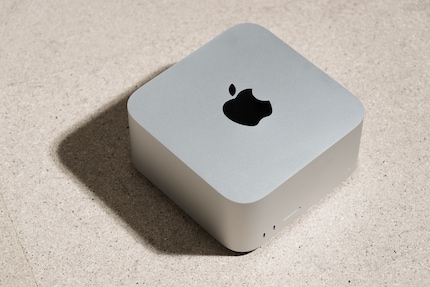
Source: Samuel Buchmann
What’s more striking than how hot the PC gets is how loud it is. Of course PCs can also be made quiet with the right fans. But they’ll never be as quiet as the Mac Studio while delivering the same performance. In regular operation, the Mac Studio is inaudible. Even during a ten-minute video export, the fan remains at 1,000 revolutions per minute (RPM). I only hear it when I hold my ear directly to the ventilation grille. It’s only under sustained full load of simultaneous CPU and GPU that the fan spins up after a few minutes and remains at 2200 RPM. That’s audible, but not at all loud.
Verdict: silent luxury computer
The M2 Ultra Mac Studio is faster than any other Apple computer. However, it’s slower than a good Windows computer in most scenarios. Depending on the application, the speed difference varies from tiny to huge. One thing’s for sure: a PC offers you much more raw performance per franc or euro than the Mac Studio – even at the currently exorbitant graphics card prices.
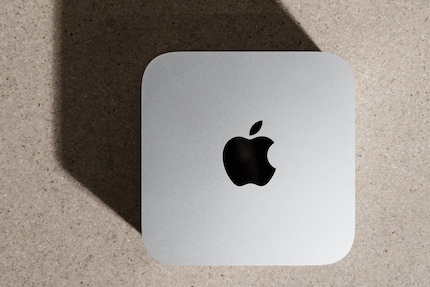
Source: Samuel Buchmann
The advantage of the Mac Studio is its efficiency. The energy consumption is many times lower than that of a PC in relation to its performance. Under load, the Intel CPU and Nvidia graphics cards each devour twice as much wattage as Apple’s entire computer. Having said that, the lower electricity bill doesn’t compensate for the higher price. But less energy consumption also means less waste heat and less noise. While the cooling system of a high-end PC has to crank up quickly, the Mac Studio does its job on the office desk largely inaudibly.
So is the Mac Studio worth its price? I’d only choose it over a high-end PC in two very specific cases. Either if you use programs that are only available for MacOS or if you want a small, quiet and yet powerful computer whatever the price. In either case, the M2 Ultra chip is only worth it if you need tons of power. If you’re asking yourself what for, you probably don’t need it. In that case, you’re better off saving your money and buying a Mac with a smaller chip. But if you belong to the small target group for this device, the Mac Studio is an excellent silent luxury computer.
My fingerprint often changes so drastically that my MacBook doesn't recognise it anymore. The reason? If I'm not clinging to a monitor or camera, I'm probably clinging to a rockface by the tips of my fingers.





